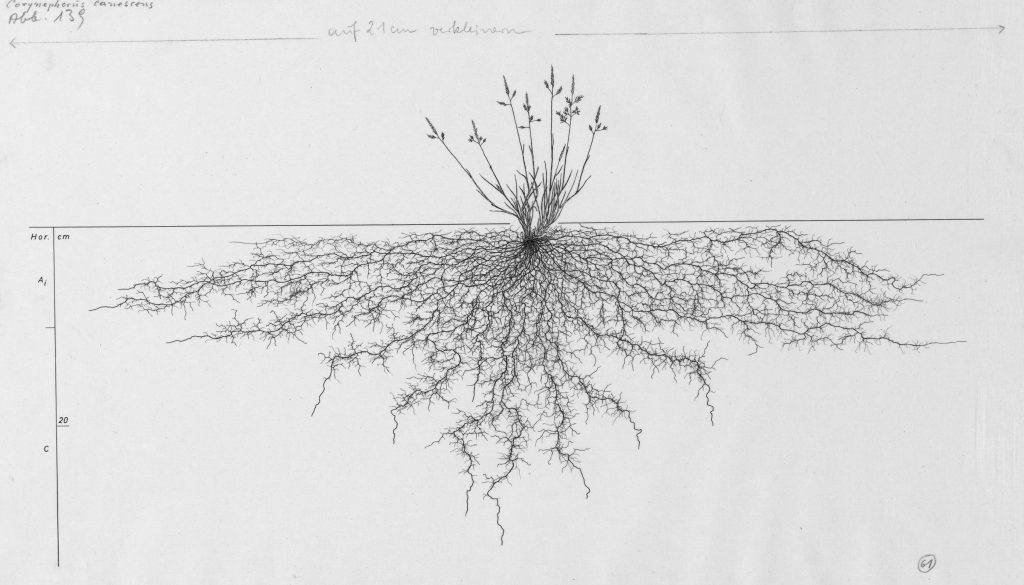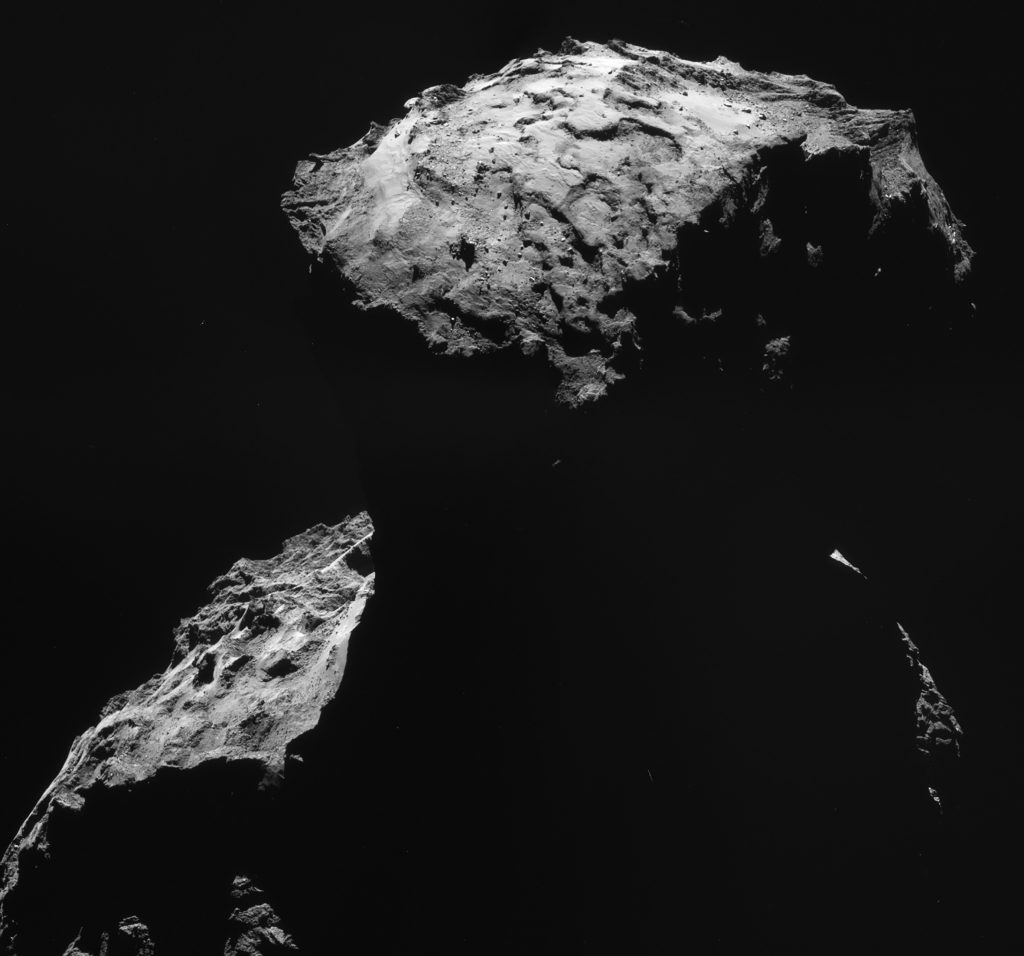Stranger than Fiction: the Reality and Fantasy of Eating in Space

Food has always formed part of the imaginative landscape of space travel. It’s the second question every astronaut is asked about their experience of being in space (the first being involved with the end results of eating), and it provides writers and movie directors with endless opportunities for playfulness. Watch any sci-fi film, and if the humans aren’t themselves becoming the food for a range of ravening space aliens, they have access to all manner of futuristic devices and foodstuffs for their own dining pleasure. This isn’t new. Fanciful food formed part of the vision for the pioneers of science fiction. In the short novel Le Voyage dans la Lune, written almost 400 years ago and first published in 1657, Cyrano de Bergerac’s travellers dine on vapours (which explains why the cooks are fatter than everyone else, even though they don’t physically ‘eat’ more), and they breakfast on larks, small birds, which when shot fall to the ground already plucked, dressed and roasted to perfection. Fast forward to the movie Star Trek–Nemesis (2002) where Captain Jean- Luc Picard gives a simple voice command to his replicator (‘tea – Earl Grey – hot’) and it materialises from nothing, steaming gently in an elegant fine china cup and saucer, while aliens drink unnervingly bright blue wine, and we can see that fictional outer space is a place where our imaginations can fly free on every level, and we can play with that most fundamental human necessity, our food.
In the early stages of research for the first real human space missions, some proposals of near-fictional outlandishness were proposed by scientists whose imaginations ran as freely as fiction writers’. Researchers in the United States investigated the use of bacteria to convert the urea in human urine into edible protein, which, they suggested, could be combined with food additives to make crackers or biscuits as a food source for astronauts. Perhaps fortunately, the results were found to cause nausea and have negative psychological effects. Others proposed making parts of the spacecraft – such as radiation shields – out of edible materials, advocated ensuring that food containers would also be edible, and even suggested using clothing fibres composed of edible materials such as soy beans, egg whites and chicken feathers. There was a strong urge to find multi-purpose solutions that would make the inedible edible, and vice versa. It was probably a huge relief to astronauts that these experiments were largely unsuccessful.
While food is fertile ground for imagination and fantasy, in both science fact and fiction, it is also a fundamentally practical matter. In more recent, realistic fantasy fictions like the film The Martian (2015), recognisable food is pivotal to the believability of the story, and the tension of the entire drama owes a great deal to the success or failure of our hero’s crop of potatoes. Contemplation of the real possibility of space travel forces us to state the obvious. Without food and water humans cannot survive. Without adequate nourishment, humans cannot function effectively. These truths apply whether we are here on Earth or travelling in the cosmos. Any real humans actually travelling into space must have practical solutions to the problem of feeding themselves, and their food needs to do more than simply keep them alive; they are engineers and scientists, working on the cutting edge of research, who need to perform at their best. Their living conditions in general and their food in particular are key to their ability to do so.
‘Highly acceptable foods can play a primary role in reducing the stress of prolonged space missions.’ Michele Perchonok and Charles Bourland, ‘NASA Food Systems: Past, Present and Future’, Nutrition, issue 18, 2002, pp 913–20.
Beyond providing the basic nourishment our bodies and brains require to function, food and the conditions in which we consume it also influence the healthy functioning of our minds. Food forms a fundamental part of culture, our individual and collective identity, our habits and our comfort. Our ideas about it, our likes and dislikes, our needs and expectations are all part of our psychological makeup. Researchers have proposed, and our own experiences tell us, that the sensory stimulation provided by food can be as important as its nutritional benefits. At its best, food can bring pleasure, relieve stress and bring groups of people together; but it can easily do the opposite. Food is a tangible necessity that can simultaneously function on multiple intangible levels. There is a lot riding on space food.
Indeed, I don’t think it is going too far to say that the entire history and future of human space flight depends on space food. Until the first pioneers went into orbit and proved it was possible, there were sincere doubts as to whether humans would be physically able to swallow food in space conditions. The first ever recorded meal in space eaten by Gherman Titov in August 1961 – purée and blackcurrant juice from tubes and meat and liver paté – and John Glenn’s tube of apple sauce in February 1962, the first meal eaten by a US astronaut in space, may seem now like fun facts, almost trivial human interest angles on the larger story of space flight, but these acts of eating were actually a scheduled and important aspect of their missions. If they had not successfully proved that they could swallow their food without choking, and later astronauts on longer missions provided additional evidence that digestion and peristalsis would still operate in microgravity, the technologists who wanted none of the distractions of human participation in space missions would have won the argument, and human space flight would remain a fantastical dream to this day.
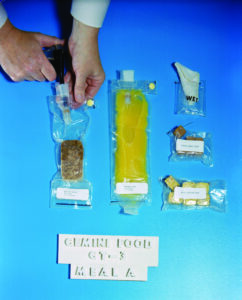
Countless projects have been undertaken during manned missions into space, but the one common to every single mission is research into the effect of space travel on the human body. It was obvious even to the public watching TV and devouring press articles that the earliest astronauts had lost weight while they were away on their mission into space. Their reduced muscle mass and bone density was less visible, and their lack of physical strength carefully hidden during triumphant landing press conferences, but the effects of even relatively short periods spent in microgravity were and are real. If the body doesn’t have to work against the resistance of gravity in order to move, muscles waste and bones get thinner. So, resident crew at the ISS spend two-and-a-half hours on six days of every week working out on a treadmill, bicycle and weight machines to help mitigate these inevitable effects, and their food is carefully balanced to ensure adequate nutritional support.
Microgravity also affects the distribution of fluid in the body. Being in space has a similar effect to lying in a bed on a slight angle with your head downhill from your feet, sending more fluid to your head. This makes the experience of space travel a bit like having a constantly stuffy nose, or blocked sinuses, which of course affects the sense of smell (as does reduced zinc intake, often a factor in space eating). Since smell represents between 75 to 95% of what we perceive as ‘taste’, this has a significant effect on the flavour and desirability of foods in space. This can be hard to anticipate in advance. Astronauts have always tasted the foods on offer before departure from Earth, and continue to select their preferences from the lists of (now) hundreds of options on that basis, but because of this temporary change to their own bodies, they often find that once they get into space it doesn’t taste quite the same. Astronauts on Skylab (1973–1974), the short-lived United States space station, reported that one of their menu options was a German potato salad that most of them found too spicy for their tastes on Earth; but once living on Skylab, it became the most delicious thing in the pantry, and the first crew ate the entire supply for all three missions. Crews on Mir, the USSR then Russian space station (1986–2000), ate their experimental spring onions to satisfy their craving for something strong-tasting as well as fresh. Today, crews of all nationalities on the ISS (International Space Station) get through quantities of condiments that stimulate the taste buds and make the food actually ‘taste’ of something. Besides salt (in pouches dissolved in water) and pepper (suspended in oil), chilli sauce is apparently especially popular with the US astronauts, while raw garlic and onion is supplied by the Russian kitchens.
These kinds of national stereotypes in food preferences, and the idea that every nationality has its own specific cuisine and national dish(es), have been played out to an almost comical degree throughout the history of human space travel. The main nations involved in the first rounds of the space race, the US and USSR, developed space-friendly versions of their most straightforward home-style food to satisfy their astronauts’ and cosmonauts’ need for both nutrition and comfort. For the US astronauts, this included dishes like chicken à la king, meat and mashed potatoes and frankfurters; for the Russians, beetroot soup (borsch), buckwheat porridge (kasha), various fish dishes and cottage cheese (tvordik). A Japanese astronaut, Soichi Hoguchi, brought ‘astro-ramen,’ a version of Momofuko Ando’s innovative instant noodles, to Space Shuttle Discovery in 2005; the first Korean in space, Ko San, had pouches of specially formulated kimchi – its fermentation stopped by irradiation – in 2008; Italian astronaut Samantha Cristoforetti brought the ISSpresso coffee machine to the ISS in 2015; and in 2016 British astronaut Tim Peake enjoyed a bacon sarnie (sandwich) developed with chef Heston Blumenthal on the ISS. China has developed increasingly sophisticated and recognisably Chinese foods for its manned missions since they began in 1996, including gong bao chicken, shredded pork with garlic, ‘eight treasure lotus’ porridge, and moon cakes. They have spent years perfecting the provision of perfectly cooked rice for their astronauts.
The French are particularly well known for their gastronomy in space, serving splendid meals accompanied by appropriate wines – apart from on the Space Shuttle, where Patrick Baudry’s wine was not allowed, though his meal of lobster, jugged hare à l’Alsacienne and pâte de fruit with cheese was. During their partnership with the Russian space agency in the twentieth century France sent several cosmonauts to Mir, all of whom arrived with their own gourmet dinner devised, prepared and packaged by a famous chef. In 1996 Claudie Haigneré’s menu included daube de boeuf, confit de canard with capers, pigeons in wine and tomato confit, washed down with wine from Alsace. Also in the late 1990s chef Richard Filippi supplied duck confit, squid in lobster sauce and toffee rice pudding, as well as his speciality of de-boned stuffed quails in wine sauce carefully sliced and stored in a 3½ ounce can. These dinners served to foster good on-board relations as well as providing accessible and enjoyable opportunities for communication with Earth.
‘Having a good meal is, of course, something more than downing one’s food. It’s a complicated process combining physiological and psychological elements. Even in a short flight, tasty, favourite dishes can provide the cosmonauts with relaxation during their strenuous work.’ Yuri Gagarin and Vladimir Lebedev, Psychology in Space, 1970
Astronaut biographies are full of examples of the power of food to improve morale, develop traditions and bring crews together – and, in some cases, keep them apart. Before the collapse of the Soviet Union, cosmonauts on Mir would occasionally receive treats like caviar and paté to celebrate events like birthdays and New Year. Helen Sharman, a British visitor to Mir in 1991, was welcomed aboard with the traditional Russian greeting of bread and salt, albeit in the form of packet bread and salt tablets. Jerry M. Lineger, a lone US astronaut with two Russian crewmates on Mir in 1997, found that sharing and enjoying his colleagues’ traditional foods (borsch, kasha and tushonka, a special canned meat) fostered good relations far more effectively than any demonstrations of work ethic or technical prowess. Shannon Lucid kept morale high with a Sunday night Jell-O party when she was commander on Mir in 1996. On the other end of the scale, a French astronaut joining a US Shuttle mission in 1985 was horrified to learn that his US commander had decided against including the optional meal trays (a personal mini table held onto the leg with Velcro) for his crew, prioritising the reduction of ‘clutter’ and declaring set meal times a waste of time. This apparently minor food-related decision exposed and emphasised a vast cultural divide.
Although today most of the food supplied to the ISS is generic processed foods in special packaging, plus whatever quantities of fresh produce such as fruit can be kept short-term and occasionally resupplied, a lot of what we tend to think of as ‘space food’ is either military rations (like food in tubes developed in the early twentieth century for high-altitude pilots and MREs, dehydrated ‘Meals Ready to Eat’) or a relic of the twentieth-century space race. The United States in particular developed new technologies in the 1960s and 1970s as well as repurposing old ones to meet the requirements of the space programme. If asked, any US citizen over the age of 45 will immediately think of Tang, the powdered citrus drink sold to the public as the favourite drink of astronauts, and every visitor to an aerospace museum will think of the freeze-dried ice cream in foil packages sold in the gift shop. Freeze drying was an important technology for early space food, where storage space in the tiny craft was at a premium and every gram of extra weight was counted (even the Band-Aids were removed from their packaging to save on space and weight). Since water was a by-product of the fuel cells, dried foods were a truly efficient solution to the problem of feeding the crew. However, the gastronomic consequences were not always fully accounted for. The food technologists were thrilled to develop freezedried mashed potato; the astronauts were less excited to eat them when rehydrated with gassy cold water (the only option on Gemini; Apollo missions were the first to have hot water, a great improvement). But no matter how long you left it to hydrate or how well you massaged the pouch, the results were not particularly appetising.
‘This food item [turkey and gravy] was highly acceptable primarily because it was familiar in appearance, flavor and texture.’ Herbert A. Hollender, Mary V. Klicka and Malcolm C. Smith, Proceedings of The Symposium on Nutrition of Man in Space, Prague 1969, 1970
Heatable ‘wetpacks’ containing thermostabilised food proved much more appealing, in particular when a package with an integrated spoon was made available, as for the turkey in gravy devised for the Apollo 8 Christmas Day meal. Not only was the food more digestible, the more realistic eating experience – spooning bite-sized pieces from pack to mouth – was found to be infinitely superior to sucking from a straw or squeezing semi-liquids from a pouch or a tube directly to the mouth. Other attempts to introduce texture into the eating experience were less successful. NASA developed a series of bite-sized cubes that would be hydrated in the mouth by saliva. Besides not looking very attractive – and the fact that without a label you would be hard-pressed to distinguish fruit cake from bacon or cheese and crackers – the edible gums coating them were either flaky, sticky or caused stomach upsets. It is tempting to look at experiments like these, made possible by generous budgets within a programme that demanded technological innovation on all fronts, as the food equivalent of the old joke that while NASA spent millions developing a ball-point pen that could write upside down, the Russians simply used a pencil.
Certainly, from the USSR’s first missions onwards, cosmonauts used the existing technology of canned food alongside the liquid foods in tubes developed for high-altitude pilots, seemingly far less concerned about (or more willing to accept) the additional weight and waste of the cans in the interests of providing recognisable foods to their crews. They also seemed more willing to deal with dangers of crumbs, allowing early cosmonauts to take bite-sized pieces of real foods such as bread, salami and candied fruit jellies with them and later providing small vacuum cleaners for clean-up rather than attempting to eliminate mess from food altogether. By contrast, the United States were fanatical about the need to eliminate crumbs, and when John Young smuggled a corned beef on rye sandwich from a local deli on board Gemini 3 in 1965 for his crewmate Gus Grissom, the result was a congressional investigation and an official reprimand.
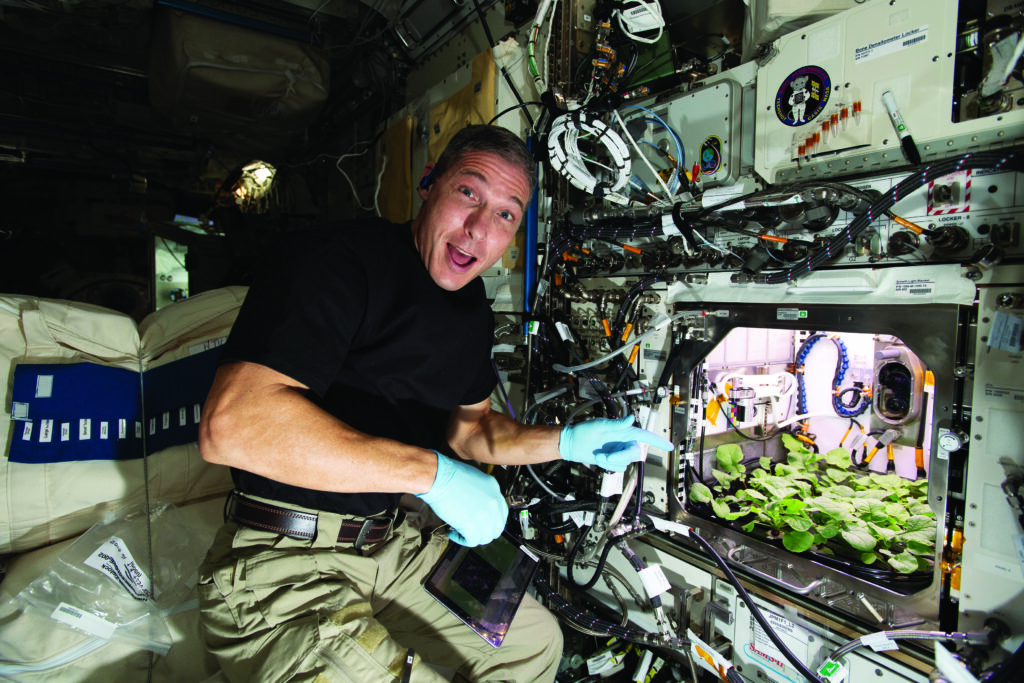
The provision of more Earth-like foods seems to be a feature of longer-term missions with more living space, and it is in space stations that we find the closest thing to a recognisable kitchen or dining experience. The Mir space station had a fridge and an oven, and a multipurpose table designed to operate as a dining table, complete with built-in heating for cans of food and suction to mitigate the escape of any crumbs or debris. When they launched their short-lived space station, Skylab, the US astronauts too had kitchen equipment including fridges, freezers, ovens and heating devices. They also adopted the idea of a dining table, a hexagonal unit designed by Raymond Loewy, around which astronauts could clip in and place their food on a heated base. The combination of conviviality and obsessive focus on their nutritional intake meant that the Skylab crews were the first ever to maintain or increase their body weight while in space. On the ISS today, efforts are still made to avoid crumbs and liquid foods are still consumed from pouches or through straws, while most foods are packed in lightweight pouches rather than in cans. However, solid foods are eaten using knives and forks from weighted trays, simulating a much more Earth-like eating experience.
In the late 1970s there was a shift away from lunar space exploration and back into the realms of fantasy when researchers’ attention turned to the possibility of establishing self-sufficient colonies in space, notably in the unrealised joint Stanford NASA studies. The various technical models and literary descriptions of life beyond the Earth such as those in Gerard K. O’Neill’s The High Frontier (1976) were made visual in an extraordinary series of specially commissioned artworks. These portray strange spheres and cylinders hovering in the darkness of deep space, with interior views showing a series of vast habitation and work modules laid out in the mode of Italian hill villages or northern Californian landscapes, with low-rise houses and lots of green space. These living quarters were to be complemented by specially designed, ultra-efficient industrial agricultural modules which would supply the colonists with fresh food, perhaps to be sold in weekend farmers’ markets. The agricultural model betrays the time and the growing gulf between different factions of society on Earth. While researchers knew from their own evidence that farming meat in space was an absurd prospect, consuming more resources than it would ever provide in outputs (and who would run the abattoir?), and growing numbers of people were advocating sustainable agriculture and vegetarian diets, they felt that conservative prospective space colonists would find it culturally unacceptable to renounce meat altogether. They therefore designed complex models which used recycled water for fish farms and fed cattle and other animals on agricultural waste, while the manure and waste water from these two would feed and nourish the plants. The artist’s realisations are spectacular, but it is hard to imagine that any such project could work.
As things stand today, and despite the fact that the ISS has been continually inhabited since 2000, no current space mission grows or cooks its own food. The ISS stores about 6 months’ worth of meals and snacks, and the larder is resupplied periodically with specific visits from the Soyuz, Progress and SpaceX vehicles and when new crew arrives. Each individual on the ISS uses more than 1.5kg of food every day, so food remains a significant overhead and logistical issue for any space mission. It simply isn’t possible to carry sufficient supplies for multiple crew members to last for multiple years making longer term and longer distance missions a challenge. In addition, distance from Earth is a key factor in the possibilities for resupply – to state the obvious, the further from Earth you have travelled, the longer it will take for another vehicle to reach you with new supplies. And, it reaching you at all depends on your having arrived at a destination where you have settled for a period of time. If you are still on the journey, moving further away every day, the chances of any space-age supermarket supply truck catching up with you seem extremely remote. This is why any serious discussion about a mission to Mars (or other planet) must involve the options for producing and processing food both en-route and on arrival.
The technologies that could make this a reality on the scale required seem to me to remain elusive. Experiments with 3D food printing have been undertaken, but since foods are generally printed from raw ingredients, giving any space mission the challenge of storing the printing equipment and the pre-processed raw ingredients, as well as requiring cooking facilities for the end result, this proposal seems to have more technical novelty than practicality. A more plant-focused space agriculture is perhaps a more practical option. It was proved early on that plants will grow successfully in space conditions, though they tend to be smaller than usual. Projects to test plant growth both in habitation modules and in experimental desert greenhouses for other planets have been ongoing for decades, and salad-growing experiments have run successfully on the ISS. At the same time various groups of basic food plants (such as onions, tomatoes, soya, potatoes, lettuce, spinach, wheat, rice) have been formulated for potential larger scale space agriculture in self-sustaining closed-loop systems. Proponents of these systems point to their ability to process waste water and faeces and output oxygen as additional benefits that go beyond mere food supply. But the challenges to put any of these systems into live practice are formidable, not least the real estate and intensive work needed to produce a crop in the vast quantities needed to actually sustain life, and the additional inputs needed to process the produce and turn it into meals. While the next generations of astronauts may well need to add the skills of farmer and cook to their long list of accomplishments, a future of simple, home-grown, freshly prepared space food is probably still a largely imaginary one.
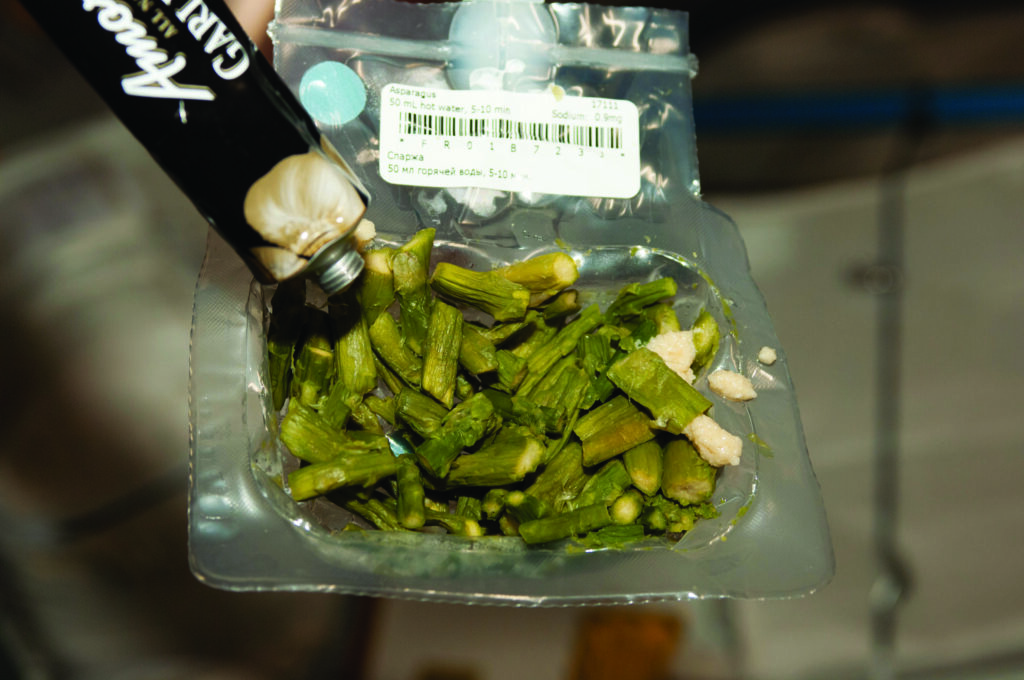
Dr Jane Levi is a food historian, writer and researcher with a particular interest in space food and utopianism. A visiting research fellow at King’s College London she contributes to its Georgian Papers Programme, focusing on dining and cookery in the eighteenth and early nineteenth centuries. With teaching colleagues at Birkbeck, University of London, she is co-author of the book Food, Politics and Society: Social Theory and the Modern Food System (University of California Press, 2018) and her writing has been published in books, journals, consumer magazines and on websites – from Gastronomica to GQ. She was co-founder of the artist’s co-operative, Edible Utopia, and co-produced its creative urban growing initiative at Somerset House, London (2016–2021). Chair and trustee of the Sophie Coe Prize in food history writing, she is also Managing Editor of the children’s literary magazine Stone Soup. She lives in London with her cat, Kimchi, and is working on her next books.
